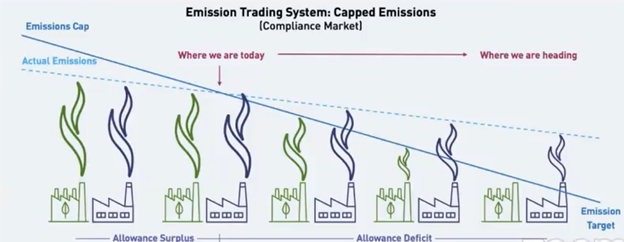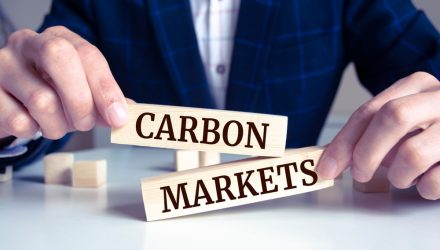The emissions transition is beginning to kick into high gear worldwide as countries globally work to curtail global warming, providing a wealth of opportunities for investors. Luke Oliver, head of climate investments at KraneShares, the first issuer to create an ETF that invests in carbon allowances globally, alongside Eron Bloomgarden, partner at Climate Finance Partners (CLIFI) gave a recent webinar on the opportunities that currently exist for investing in carbon allowances that are positioned to capture, drive, and capitalize on the global emissions transition.
KraneShares currently offers investment opportunities within the three pillars of carbon transition: investing long in the carbon markets, investing in the transition equities that are optimally positioned to “monetize” the demands created by changing emissions practices globally, and the commodity metals needed to power electrification in the move away from fossil fuels.
“All of these are pure investment theses… that are not driven by impact; these are investments that have impact,” Oliver explained. “This is something that all investors should be considering regardless of your view or taste on ESG.”
The Biggest Short in History
Despite the emissions headway being made in some industries, Oliver explained that fossil fuel demand continues to grow exponentially in developing countries in Africa, India, and China where the rapidly growing middle class is driving up electricity demand.
“I’ve been calling this the biggest short because it’s almost as if we’ve put all of this carbon into the atmosphere and never paid for it,” Oliver said.
That reckoning is coming now and to try and curtail global warming to as close to a 1.5 degree Celsius rise as possible, it’s going to take an estimated $140 trillion funneled into decarbonization efforts.
One of the primary ways that the transition away from fossil fuels and greenhouse gas-emitting fuel sources is being driven is through regulated carbon allowances markets or cap-and-trade systems in which one ton of carbon emissions equates to one allowance. Industries and companies that fall under a regulatory cap-and-trade market are allotted a certain number of allowances each year, and then a predetermined number of allowances are auctioned off each year, allowing the market to engage in price discovery for the cost of allowances.

Image source: KraneShares webinar
In order to meet the emissions reduction trajectory necessary to curtail global warming, the number of allowances available is reduced over time, creating scarcity and increasing the price to pollute.
“This doesn’t directly hamper businesses; businesses have the choice to continue polluting and having to pay an increasingly higher price for their pollution or they can innovate or switch away from those polluting activities,” explained Oliver. “After 10 years, these markets are finally at this inflection point where supply is tightening and that’s why so many investors are getting long these compliance markets today.”
Revenue made from carbon allowances auctions is channeled into a number of initiatives: 76% of revenue from the EU’s cap-and-trade system (EU ETS) has gone to energy-related and climate purposes, California has been able to meet renewable energy goals two years ahead of target, and the EU’s Innovation Fund will contribute approximately $40.8 billion to developing low-carbon technologies.
“Right now the average global price of these compliance markets is about $48 a ton,” Oliver said. “Almost every forecast projection for these markets starts at about $100 a ton.”
The Bull Case for Carbon Investing Looking Ahead
Carbon allowances were one of the best-performing commodities in 2021 but plateaued in 2022 due to geopolitical tensions driven by Russia’s invasion of Ukraine and the subsequent shocks to Europe’s energy market that had previously relied heavily on Russian fossil fuels. Despite the leveling off last year, Eron Bloomgarden of CLIFI believes that the foundational outlook remains strong for carbon markets looking ahead.
“Our view is that the fundamentals from medium- to long-term are still very bullish in this market,” Bloomgarden said.
In the near term, CLIFI is also bullish due to the temporary increased reliance on coal that has driven emissions higher in much of Europe alongside tightening regulations that could see prices driven ever higher. Supply scarcity is likely to be created by increased demand as emissions grow with the ending of economic downturn in the short term as well as an underlying demand pressure driven by the current lack of emissions abatement technologies that are cost-efficient for companies and industries.
All of it provides a “very compelling case for this market: all the stars are aligning for the disruption of 2022 to move beyond that and now see the market really engage again in the march higher and march towards lower emissions in these covered economies,” said Oliver.
KraneShares’ carbon allowances suite of funds includes the KraneShares Global Carbon Strategy ETF (KRBN), an ETF that invests in carbon allowances futures globally from the EU, California, RGGI, and the U.K.; the more targeted KraneShares European Carbon Allowance Strategy ETF (KEUA); and the KraneShares California Carbon Allowance Strategy ETF (KCCA).
For more news, information, and analysis, visit the Climate Insights Channel.

